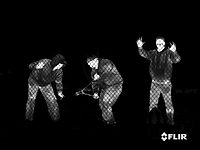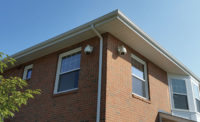Using Thermal to Deter Construction Equipment Theft

Construction companies and job sites lose as much as $1 billion annually from equipment theft, according to the 2016 Equipment Theft Report published by the National Equipment Register (NER) and the National Insurance Crime Bureau (NICB). Theft of materials, such as copper plumbing and other construction materials drives these losses even higher. Contractors are all too familiar with these statistics, as construction sites are some of the hardest hit locations for intrusion, vandalism and burglary. These losses can be significantly reduced, or stopped altogether, with appropriate use of surveillance technologies like thermal cameras, as shown below.
The first security challenge starts at the perimeter of the site. With such large, open areas, it can be expensive and impractical to install fencing or barriers around the entire property. This leaves sites vulnerable to trespassers and exposes equipment such as skid-steer loaders, generators, and welders to theft. In the aforementioned 2016 report, NER states, “the average estimated value of a stolen piece of equipment is $29,258.” Loss of equipment is not only costly, but it can also cause project delays, generating even more unexpected expenses for construction firms.
Construction sites often neglect to install security and surveillance equipment. This can be due to an inability to find solutions that are suitably rugged, easy to deploy, and able to work properly at job sites that often lack sufficient lighting at night. As a result, loss of equipment can go unnoticed for days, and when it is discovered no details of how or when it occurred are available. This hampers recovery efforts, which are already difficult as is. In 2016, the NICB compiled 11,754 reports of stolen equipment, and only 21 percent of equipment was recovered.
Security budgets may be limited, which makes the deployment of solutions that are time-consuming to install impractical. Intrusion detection solutions utilizing technologies such as fiber optic perimeter fencing systems, beam-break sensors, or outdoor motion detectors are examples of those whose costs often outweigh benefits. Such systems can be costly to install and fine-tune and may be rendered inoperable by activities at the site that knock equipment out of alignment, requiring costly technician trips to reset the devices. Video analytics can be a practical approach, with camera mounted centrally, out of harms way, and monitoring the perimeter for intruders. However, analytics systems that rely on visible cameras often require substantial lighting to be effective at night, when most crime occurs. Well-lit construction sites can potentially attract more theft, as thieves can easily spot on-site equipment that has a high grey-market value. Even with sufficient lighting, visible cameras with analytics can be hampered by weather conditions that prevent them from seeing beyond a few feet, rendering the blind. Further, tarps and loose materials on the site may get blown around, causing them to trigger some analytics, generating excessive false alarms, which erodes the bottom lime and causes distrust of the system in general.
Thermal cameras can solve many of these problems. By pairing thermal cameras with video analytics, security professionals can offer a solution that does not rely on visible light, affords the ability to see through moderate weather conditions, maintaining protection where visible systems fail. By detecting heat instead of light, thermal cameras will identify an intruder as a well-defined hot object, relative to the atmosphere, and nuisance items like tarps or materials will appear much differently, making them easier for analytics to ignore. Use of thermal cameras with analytics has been steadily increasing as more security professionals recognize the value and reliability of these systems.
In the past, thermal imagers were often considered to be military-grade solutions better suited for covert, government operations. Now, thermal has become more affordable, opening the door to a broader range of commercial deployments. In the construction sector, thermal cameras have become a game-changer for perimeter security, illustrating why implementing first-class technology is valuable and effective. With thermal cameras, an approaching person, object or vehicle, can be detected in total darkness, or through sun glare, rain, fog, smoke and foliage. With long-range detection, sharp images, and high-performing video analytics, thermal cameras reduce false alarms, and therefore, lower the overall total cost of ownership for the construction firm.
Remote monitoring enables customers to receive the benefits of an on-site guard, but at a much lower cost. This is achieved via solutions combining multiple technologies, such as thermal imagers, analytics, and optical sensors, integrated into an easily deployable package. Remote security personnel can receive intrusion notifications and verify them video clips showing both thermal and color images for maximum situation awareness. These combined technology solutions also enable security operators to better determine whether an individual on the property is a construction worker who forgot his ID or a suspect who warrants an audible warning and a police dispatch.
Together, thermal-based analytics and virtual guarding technologies provide a new level of 24/7 protection and peace of mind for construction sites and will continue to see rapid adoption across the construction sector in the years to come.
Looking for a reprint of this article?
From high-res PDFs to custom plaques, order your copy today!






